How Multinational Companies Improve Employee HR Practices at Nestle
VerifiedAdded on 2021/02/20
|25
|5665
|78
Report
AI Summary
This report analyzes how multinational companies, using Nestle as a case study, enhance their recruitment, selection, and training processes to meet international requirements. The introduction highlights the importance of these practices for global business operations. Task 1 outlines the project's aim, objectives, research questions, and a detailed project management plan, including scope, communication strategies, resource allocation, and risk assessment. Task 2 delves into the research methodologies employed, differentiating between primary and secondary research, as well as qualitative and quantitative approaches, with a rationale for the chosen methods. Task 3 focuses on data collection and analysis, while Task 4 evaluates the value of the research and its impact on the researcher's learning and performance. The report covers work breakdown structures, Gantt charts, and cost budgets to provide a comprehensive overview of the project.
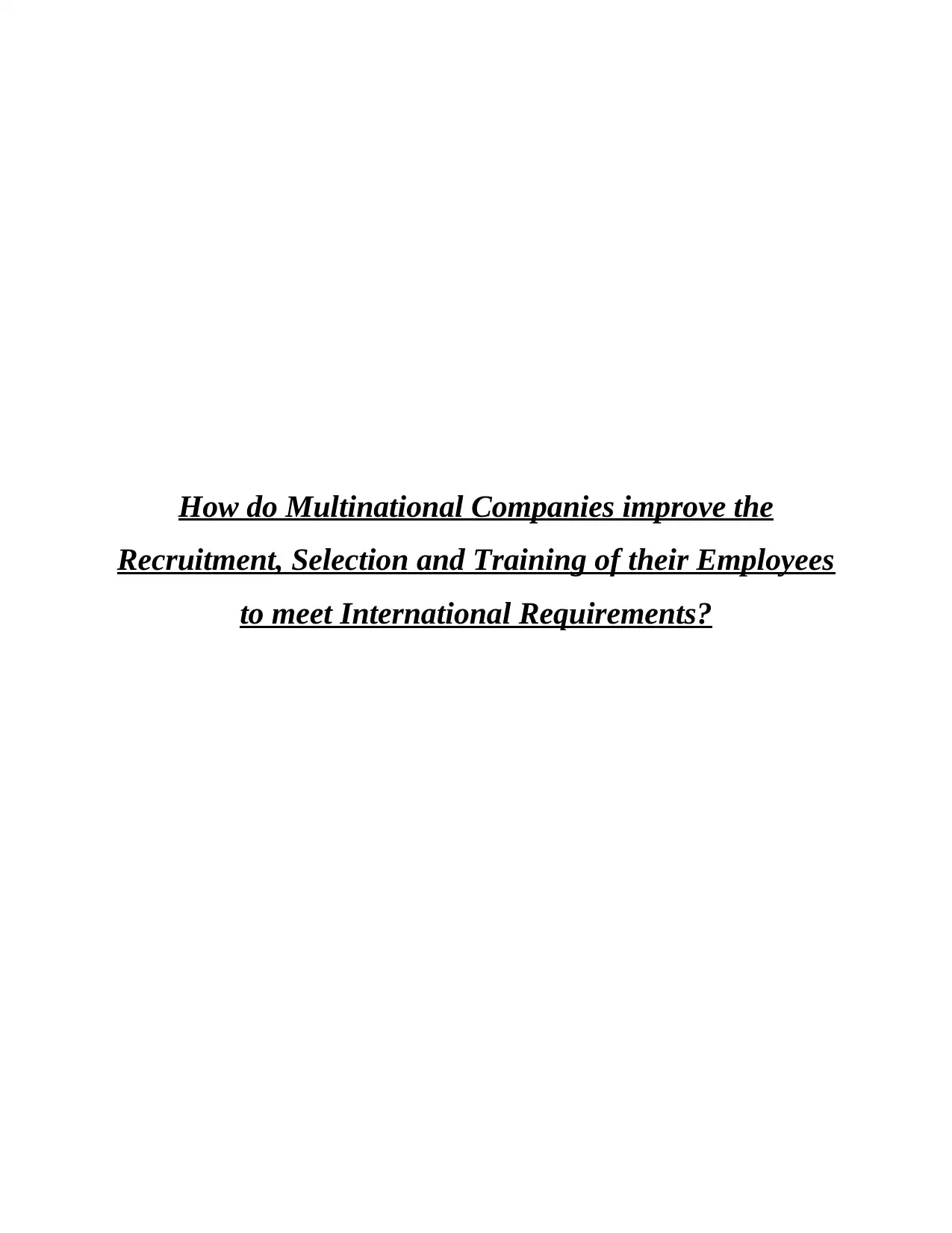
How do Multinational Companies improve the
Recruitment, Selection and Training of their Employees
to meet International Requirements?
Recruitment, Selection and Training of their Employees
to meet International Requirements?
Paraphrase This Document
Need a fresh take? Get an instant paraphrase of this document with our AI Paraphraser
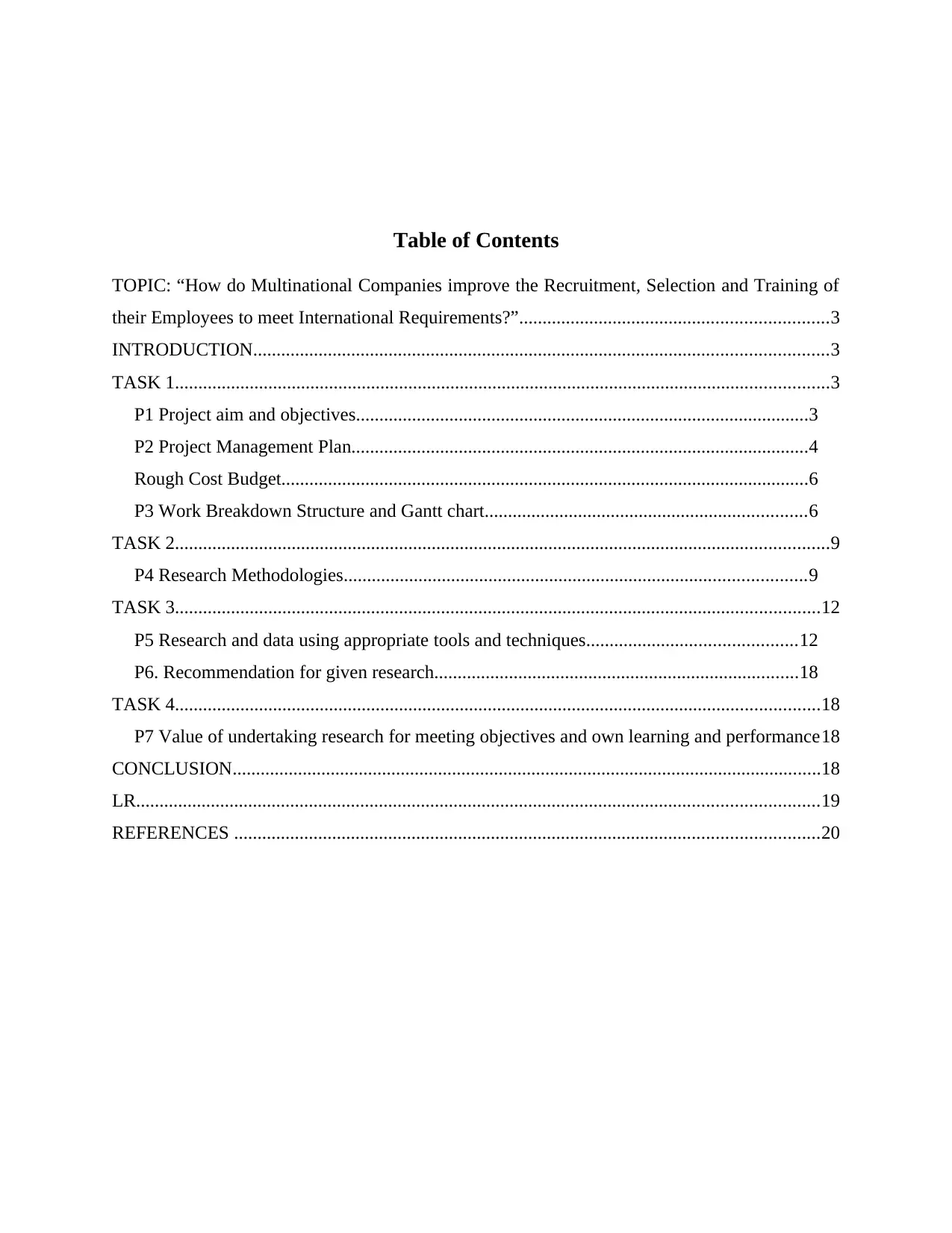
Table of Contents
TOPIC: “How do Multinational Companies improve the Recruitment, Selection and Training of
their Employees to meet International Requirements?”..................................................................3
INTRODUCTION...........................................................................................................................3
TASK 1............................................................................................................................................3
P1 Project aim and objectives.................................................................................................3
P2 Project Management Plan..................................................................................................4
Rough Cost Budget.................................................................................................................6
P3 Work Breakdown Structure and Gantt chart.....................................................................6
TASK 2............................................................................................................................................9
P4 Research Methodologies...................................................................................................9
TASK 3..........................................................................................................................................12
P5 Research and data using appropriate tools and techniques.............................................12
P6. Recommendation for given research..............................................................................18
TASK 4..........................................................................................................................................18
P7 Value of undertaking research for meeting objectives and own learning and performance18
CONCLUSION..............................................................................................................................18
LR..................................................................................................................................................19
REFERENCES .............................................................................................................................20
TOPIC: “How do Multinational Companies improve the Recruitment, Selection and Training of
their Employees to meet International Requirements?”..................................................................3
INTRODUCTION...........................................................................................................................3
TASK 1............................................................................................................................................3
P1 Project aim and objectives.................................................................................................3
P2 Project Management Plan..................................................................................................4
Rough Cost Budget.................................................................................................................6
P3 Work Breakdown Structure and Gantt chart.....................................................................6
TASK 2............................................................................................................................................9
P4 Research Methodologies...................................................................................................9
TASK 3..........................................................................................................................................12
P5 Research and data using appropriate tools and techniques.............................................12
P6. Recommendation for given research..............................................................................18
TASK 4..........................................................................................................................................18
P7 Value of undertaking research for meeting objectives and own learning and performance18
CONCLUSION..............................................................................................................................18
LR..................................................................................................................................................19
REFERENCES .............................................................................................................................20
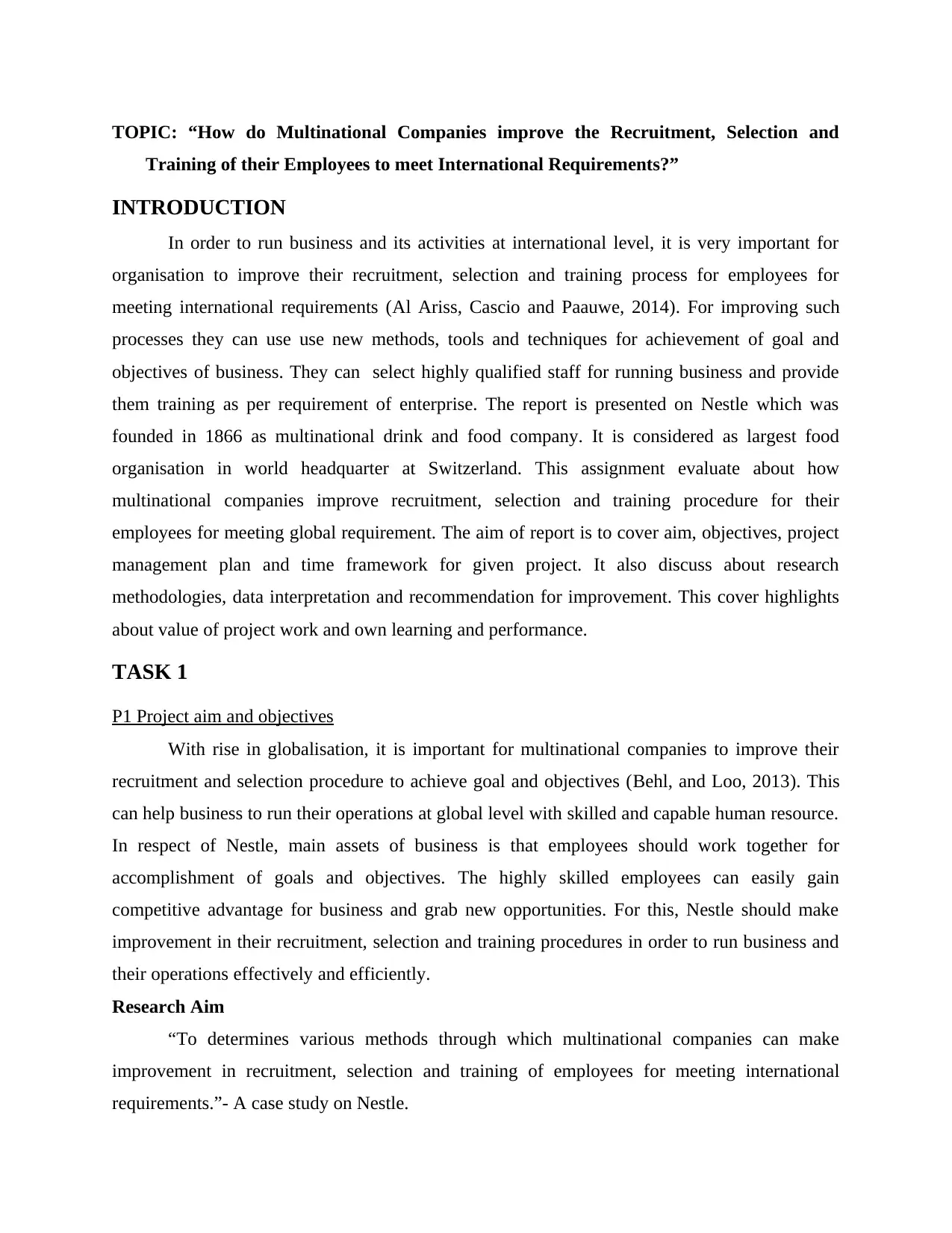
TOPIC: “How do Multinational Companies improve the Recruitment, Selection and
Training of their Employees to meet International Requirements?”
INTRODUCTION
In order to run business and its activities at international level, it is very important for
organisation to improve their recruitment, selection and training process for employees for
meeting international requirements (Al Ariss, Cascio and Paauwe, 2014). For improving such
processes they can use use new methods, tools and techniques for achievement of goal and
objectives of business. They can select highly qualified staff for running business and provide
them training as per requirement of enterprise. The report is presented on Nestle which was
founded in 1866 as multinational drink and food company. It is considered as largest food
organisation in world headquarter at Switzerland. This assignment evaluate about how
multinational companies improve recruitment, selection and training procedure for their
employees for meeting global requirement. The aim of report is to cover aim, objectives, project
management plan and time framework for given project. It also discuss about research
methodologies, data interpretation and recommendation for improvement. This cover highlights
about value of project work and own learning and performance.
TASK 1
P1 Project aim and objectives
With rise in globalisation, it is important for multinational companies to improve their
recruitment and selection procedure to achieve goal and objectives (Behl, and Loo, 2013). This
can help business to run their operations at global level with skilled and capable human resource.
In respect of Nestle, main assets of business is that employees should work together for
accomplishment of goals and objectives. The highly skilled employees can easily gain
competitive advantage for business and grab new opportunities. For this, Nestle should make
improvement in their recruitment, selection and training procedures in order to run business and
their operations effectively and efficiently.
Research Aim
“To determines various methods through which multinational companies can make
improvement in recruitment, selection and training of employees for meeting international
requirements.”- A case study on Nestle.
Training of their Employees to meet International Requirements?”
INTRODUCTION
In order to run business and its activities at international level, it is very important for
organisation to improve their recruitment, selection and training process for employees for
meeting international requirements (Al Ariss, Cascio and Paauwe, 2014). For improving such
processes they can use use new methods, tools and techniques for achievement of goal and
objectives of business. They can select highly qualified staff for running business and provide
them training as per requirement of enterprise. The report is presented on Nestle which was
founded in 1866 as multinational drink and food company. It is considered as largest food
organisation in world headquarter at Switzerland. This assignment evaluate about how
multinational companies improve recruitment, selection and training procedure for their
employees for meeting global requirement. The aim of report is to cover aim, objectives, project
management plan and time framework for given project. It also discuss about research
methodologies, data interpretation and recommendation for improvement. This cover highlights
about value of project work and own learning and performance.
TASK 1
P1 Project aim and objectives
With rise in globalisation, it is important for multinational companies to improve their
recruitment and selection procedure to achieve goal and objectives (Behl, and Loo, 2013). This
can help business to run their operations at global level with skilled and capable human resource.
In respect of Nestle, main assets of business is that employees should work together for
accomplishment of goals and objectives. The highly skilled employees can easily gain
competitive advantage for business and grab new opportunities. For this, Nestle should make
improvement in their recruitment, selection and training procedures in order to run business and
their operations effectively and efficiently.
Research Aim
“To determines various methods through which multinational companies can make
improvement in recruitment, selection and training of employees for meeting international
requirements.”- A case study on Nestle.
⊘ This is a preview!⊘
Do you want full access?
Subscribe today to unlock all pages.

Trusted by 1+ million students worldwide
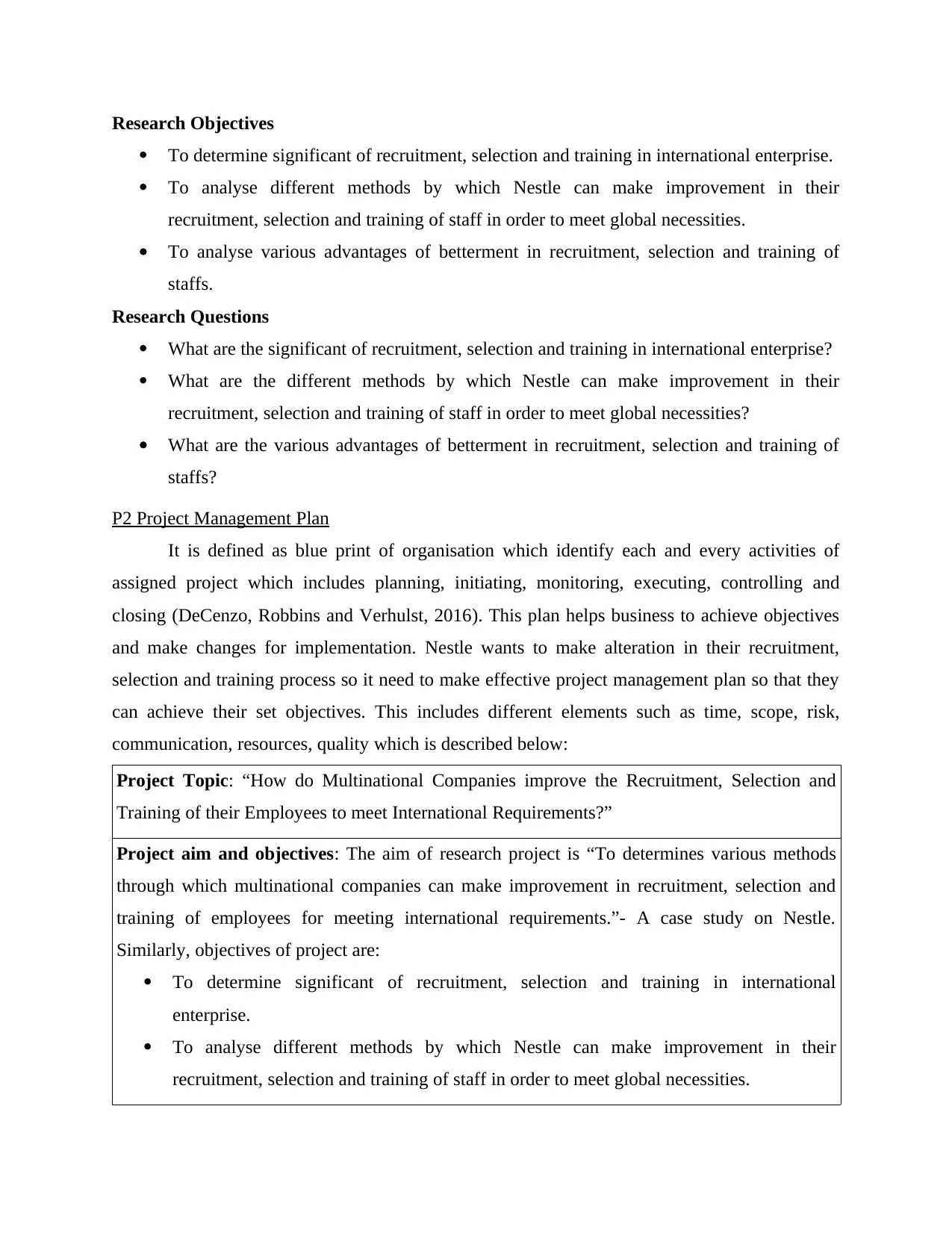
Research Objectives
To determine significant of recruitment, selection and training in international enterprise.
To analyse different methods by which Nestle can make improvement in their
recruitment, selection and training of staff in order to meet global necessities.
To analyse various advantages of betterment in recruitment, selection and training of
staffs.
Research Questions
What are the significant of recruitment, selection and training in international enterprise?
What are the different methods by which Nestle can make improvement in their
recruitment, selection and training of staff in order to meet global necessities?
What are the various advantages of betterment in recruitment, selection and training of
staffs?
P2 Project Management Plan
It is defined as blue print of organisation which identify each and every activities of
assigned project which includes planning, initiating, monitoring, executing, controlling and
closing (DeCenzo, Robbins and Verhulst, 2016). This plan helps business to achieve objectives
and make changes for implementation. Nestle wants to make alteration in their recruitment,
selection and training process so it need to make effective project management plan so that they
can achieve their set objectives. This includes different elements such as time, scope, risk,
communication, resources, quality which is described below:
Project Topic: “How do Multinational Companies improve the Recruitment, Selection and
Training of their Employees to meet International Requirements?”
Project aim and objectives: The aim of research project is “To determines various methods
through which multinational companies can make improvement in recruitment, selection and
training of employees for meeting international requirements.”- A case study on Nestle.
Similarly, objectives of project are:
To determine significant of recruitment, selection and training in international
enterprise.
To analyse different methods by which Nestle can make improvement in their
recruitment, selection and training of staff in order to meet global necessities.
To determine significant of recruitment, selection and training in international enterprise.
To analyse different methods by which Nestle can make improvement in their
recruitment, selection and training of staff in order to meet global necessities.
To analyse various advantages of betterment in recruitment, selection and training of
staffs.
Research Questions
What are the significant of recruitment, selection and training in international enterprise?
What are the different methods by which Nestle can make improvement in their
recruitment, selection and training of staff in order to meet global necessities?
What are the various advantages of betterment in recruitment, selection and training of
staffs?
P2 Project Management Plan
It is defined as blue print of organisation which identify each and every activities of
assigned project which includes planning, initiating, monitoring, executing, controlling and
closing (DeCenzo, Robbins and Verhulst, 2016). This plan helps business to achieve objectives
and make changes for implementation. Nestle wants to make alteration in their recruitment,
selection and training process so it need to make effective project management plan so that they
can achieve their set objectives. This includes different elements such as time, scope, risk,
communication, resources, quality which is described below:
Project Topic: “How do Multinational Companies improve the Recruitment, Selection and
Training of their Employees to meet International Requirements?”
Project aim and objectives: The aim of research project is “To determines various methods
through which multinational companies can make improvement in recruitment, selection and
training of employees for meeting international requirements.”- A case study on Nestle.
Similarly, objectives of project are:
To determine significant of recruitment, selection and training in international
enterprise.
To analyse different methods by which Nestle can make improvement in their
recruitment, selection and training of staff in order to meet global necessities.
Paraphrase This Document
Need a fresh take? Get an instant paraphrase of this document with our AI Paraphraser
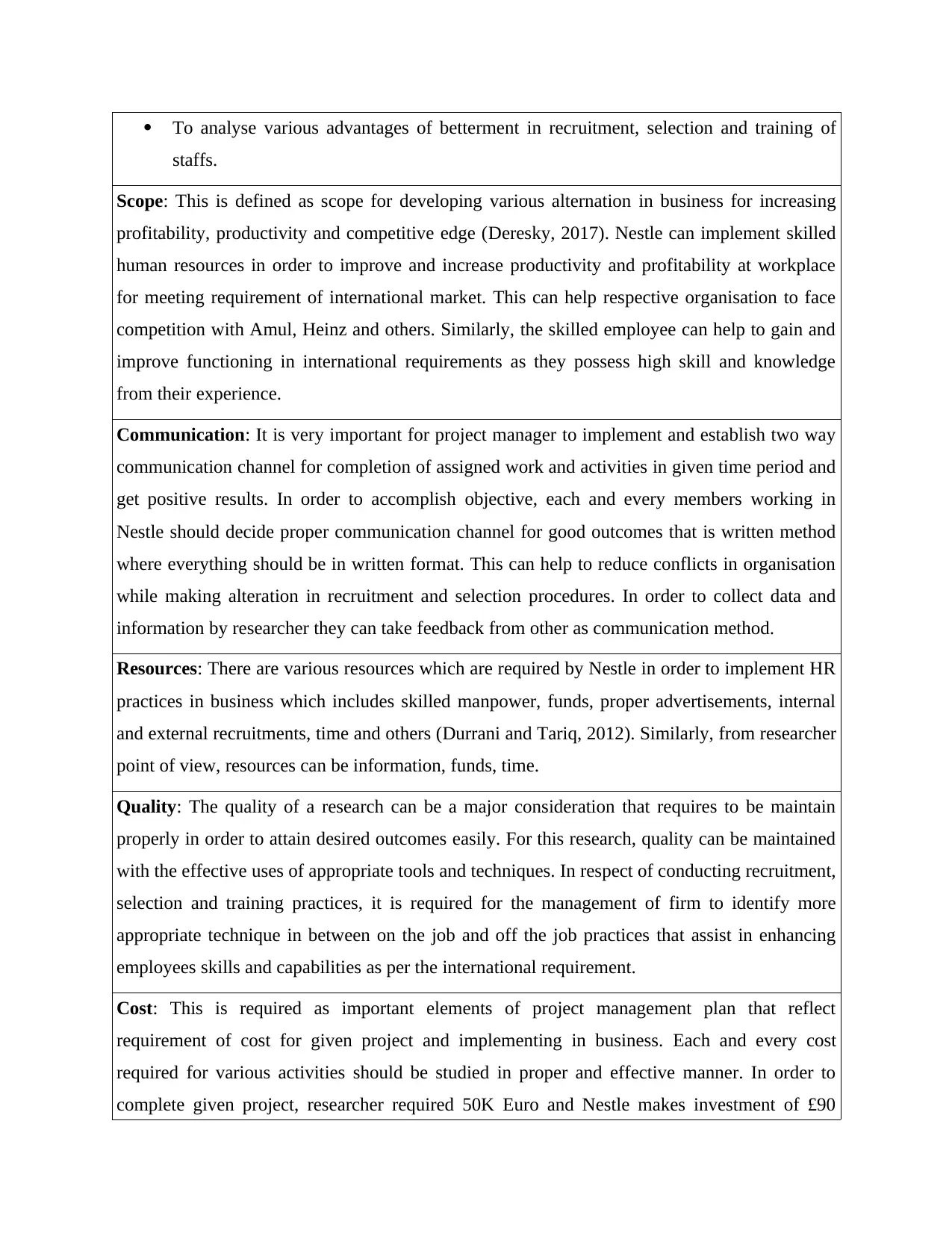
To analyse various advantages of betterment in recruitment, selection and training of
staffs.
Scope: This is defined as scope for developing various alternation in business for increasing
profitability, productivity and competitive edge (Deresky, 2017). Nestle can implement skilled
human resources in order to improve and increase productivity and profitability at workplace
for meeting requirement of international market. This can help respective organisation to face
competition with Amul, Heinz and others. Similarly, the skilled employee can help to gain and
improve functioning in international requirements as they possess high skill and knowledge
from their experience.
Communication: It is very important for project manager to implement and establish two way
communication channel for completion of assigned work and activities in given time period and
get positive results. In order to accomplish objective, each and every members working in
Nestle should decide proper communication channel for good outcomes that is written method
where everything should be in written format. This can help to reduce conflicts in organisation
while making alteration in recruitment and selection procedures. In order to collect data and
information by researcher they can take feedback from other as communication method.
Resources: There are various resources which are required by Nestle in order to implement HR
practices in business which includes skilled manpower, funds, proper advertisements, internal
and external recruitments, time and others (Durrani and Tariq, 2012). Similarly, from researcher
point of view, resources can be information, funds, time.
Quality: The quality of a research can be a major consideration that requires to be maintain
properly in order to attain desired outcomes easily. For this research, quality can be maintained
with the effective uses of appropriate tools and techniques. In respect of conducting recruitment,
selection and training practices, it is required for the management of firm to identify more
appropriate technique in between on the job and off the job practices that assist in enhancing
employees skills and capabilities as per the international requirement.
Cost: This is required as important elements of project management plan that reflect
requirement of cost for given project and implementing in business. Each and every cost
required for various activities should be studied in proper and effective manner. In order to
complete given project, researcher required 50K Euro and Nestle makes investment of £90
staffs.
Scope: This is defined as scope for developing various alternation in business for increasing
profitability, productivity and competitive edge (Deresky, 2017). Nestle can implement skilled
human resources in order to improve and increase productivity and profitability at workplace
for meeting requirement of international market. This can help respective organisation to face
competition with Amul, Heinz and others. Similarly, the skilled employee can help to gain and
improve functioning in international requirements as they possess high skill and knowledge
from their experience.
Communication: It is very important for project manager to implement and establish two way
communication channel for completion of assigned work and activities in given time period and
get positive results. In order to accomplish objective, each and every members working in
Nestle should decide proper communication channel for good outcomes that is written method
where everything should be in written format. This can help to reduce conflicts in organisation
while making alteration in recruitment and selection procedures. In order to collect data and
information by researcher they can take feedback from other as communication method.
Resources: There are various resources which are required by Nestle in order to implement HR
practices in business which includes skilled manpower, funds, proper advertisements, internal
and external recruitments, time and others (Durrani and Tariq, 2012). Similarly, from researcher
point of view, resources can be information, funds, time.
Quality: The quality of a research can be a major consideration that requires to be maintain
properly in order to attain desired outcomes easily. For this research, quality can be maintained
with the effective uses of appropriate tools and techniques. In respect of conducting recruitment,
selection and training practices, it is required for the management of firm to identify more
appropriate technique in between on the job and off the job practices that assist in enhancing
employees skills and capabilities as per the international requirement.
Cost: This is required as important elements of project management plan that reflect
requirement of cost for given project and implementing in business. Each and every cost
required for various activities should be studied in proper and effective manner. In order to
complete given project, researcher required 50K Euro and Nestle makes investment of £90
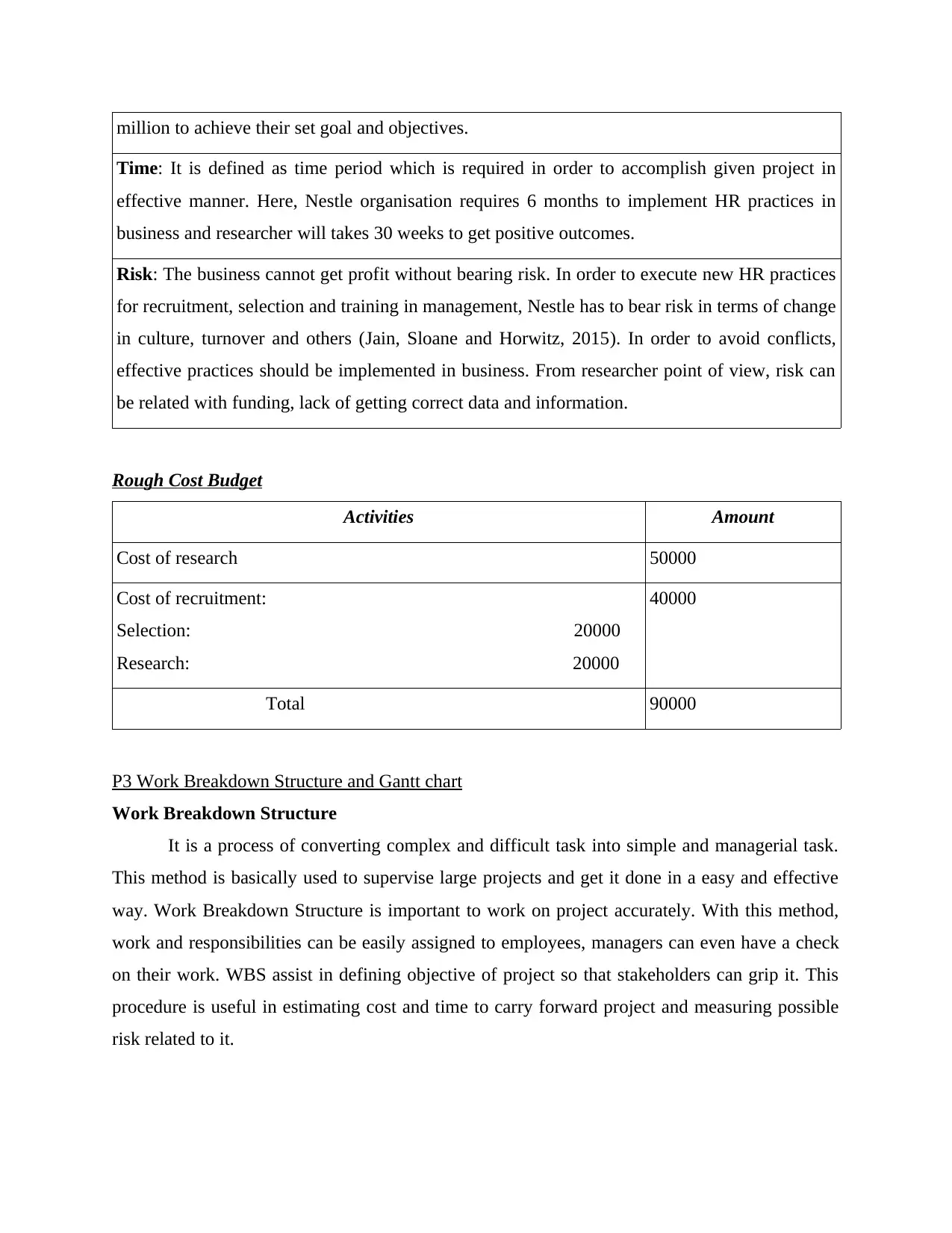
million to achieve their set goal and objectives.
Time: It is defined as time period which is required in order to accomplish given project in
effective manner. Here, Nestle organisation requires 6 months to implement HR practices in
business and researcher will takes 30 weeks to get positive outcomes.
Risk: The business cannot get profit without bearing risk. In order to execute new HR practices
for recruitment, selection and training in management, Nestle has to bear risk in terms of change
in culture, turnover and others (Jain, Sloane and Horwitz, 2015). In order to avoid conflicts,
effective practices should be implemented in business. From researcher point of view, risk can
be related with funding, lack of getting correct data and information.
Rough Cost Budget
Activities Amount
Cost of research 50000
Cost of recruitment:
Selection: 20000
Research: 20000
40000
Total 90000
P3 Work Breakdown Structure and Gantt chart
Work Breakdown Structure
It is a process of converting complex and difficult task into simple and managerial task.
This method is basically used to supervise large projects and get it done in a easy and effective
way. Work Breakdown Structure is important to work on project accurately. With this method,
work and responsibilities can be easily assigned to employees, managers can even have a check
on their work. WBS assist in defining objective of project so that stakeholders can grip it. This
procedure is useful in estimating cost and time to carry forward project and measuring possible
risk related to it.
Time: It is defined as time period which is required in order to accomplish given project in
effective manner. Here, Nestle organisation requires 6 months to implement HR practices in
business and researcher will takes 30 weeks to get positive outcomes.
Risk: The business cannot get profit without bearing risk. In order to execute new HR practices
for recruitment, selection and training in management, Nestle has to bear risk in terms of change
in culture, turnover and others (Jain, Sloane and Horwitz, 2015). In order to avoid conflicts,
effective practices should be implemented in business. From researcher point of view, risk can
be related with funding, lack of getting correct data and information.
Rough Cost Budget
Activities Amount
Cost of research 50000
Cost of recruitment:
Selection: 20000
Research: 20000
40000
Total 90000
P3 Work Breakdown Structure and Gantt chart
Work Breakdown Structure
It is a process of converting complex and difficult task into simple and managerial task.
This method is basically used to supervise large projects and get it done in a easy and effective
way. Work Breakdown Structure is important to work on project accurately. With this method,
work and responsibilities can be easily assigned to employees, managers can even have a check
on their work. WBS assist in defining objective of project so that stakeholders can grip it. This
procedure is useful in estimating cost and time to carry forward project and measuring possible
risk related to it.
⊘ This is a preview!⊘
Do you want full access?
Subscribe today to unlock all pages.

Trusted by 1+ million students worldwide
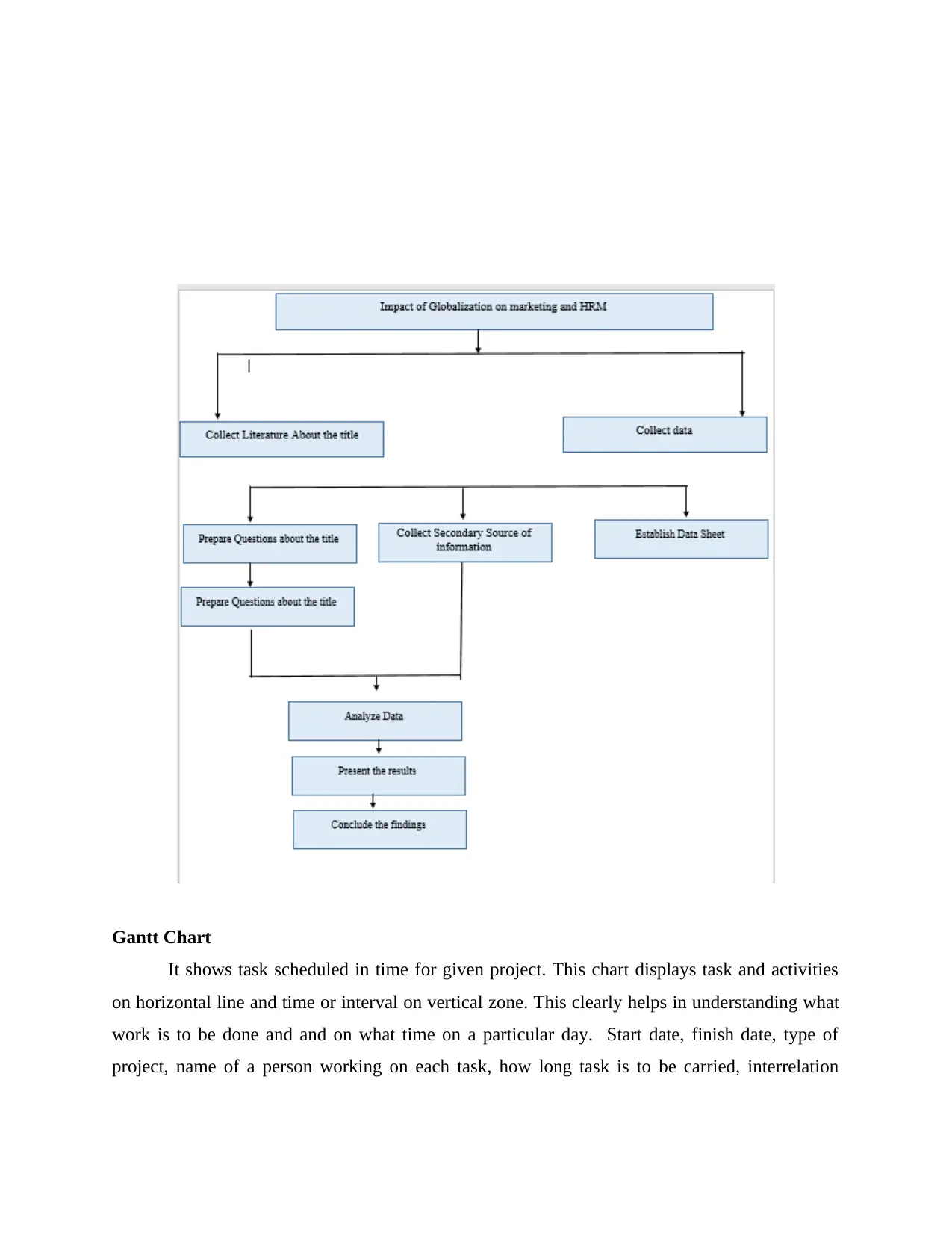
Gantt Chart
It shows task scheduled in time for given project. This chart displays task and activities
on horizontal line and time or interval on vertical zone. This clearly helps in understanding what
work is to be done and and on what time on a particular day. Start date, finish date, type of
project, name of a person working on each task, how long task is to be carried, interrelation
It shows task scheduled in time for given project. This chart displays task and activities
on horizontal line and time or interval on vertical zone. This clearly helps in understanding what
work is to be done and and on what time on a particular day. Start date, finish date, type of
project, name of a person working on each task, how long task is to be carried, interrelation
Paraphrase This Document
Need a fresh take? Get an instant paraphrase of this document with our AI Paraphraser
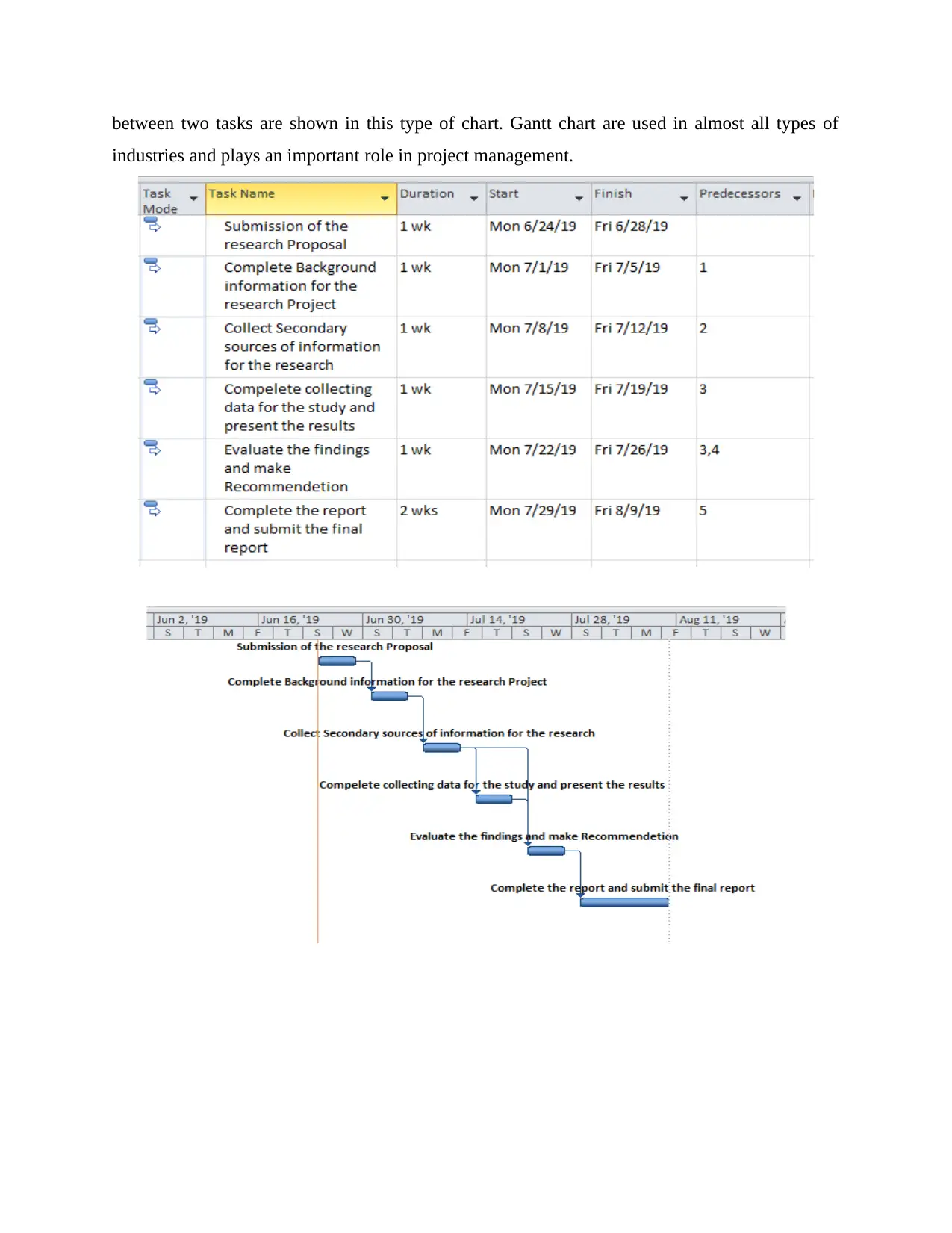
between two tasks are shown in this type of chart. Gantt chart are used in almost all types of
industries and plays an important role in project management.
industries and plays an important role in project management.
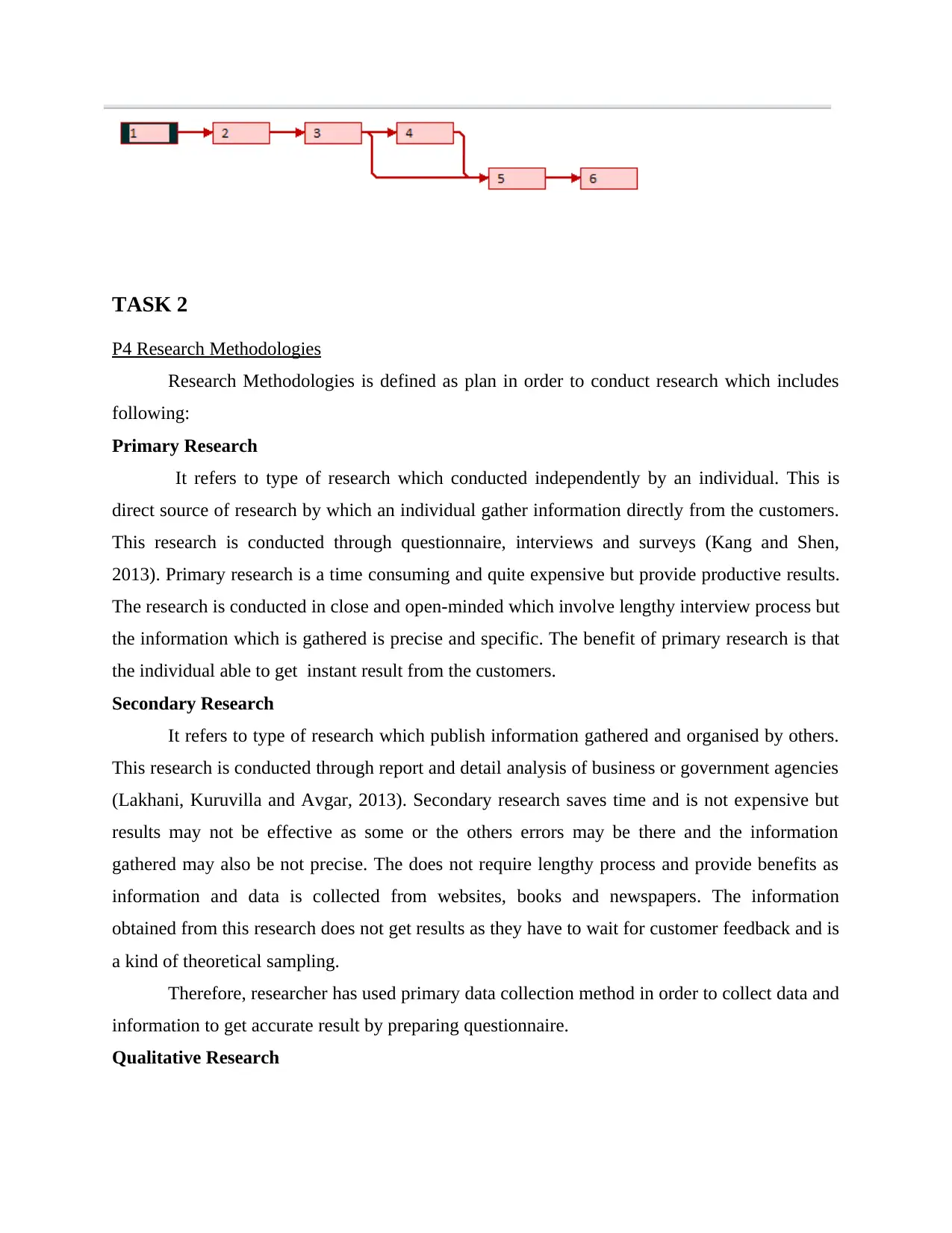
TASK 2
P4 Research Methodologies
Research Methodologies is defined as plan in order to conduct research which includes
following:
Primary Research
It refers to type of research which conducted independently by an individual. This is
direct source of research by which an individual gather information directly from the customers.
This research is conducted through questionnaire, interviews and surveys (Kang and Shen,
2013). Primary research is a time consuming and quite expensive but provide productive results.
The research is conducted in close and open-minded which involve lengthy interview process but
the information which is gathered is precise and specific. The benefit of primary research is that
the individual able to get instant result from the customers.
Secondary Research
It refers to type of research which publish information gathered and organised by others.
This research is conducted through report and detail analysis of business or government agencies
(Lakhani, Kuruvilla and Avgar, 2013). Secondary research saves time and is not expensive but
results may not be effective as some or the others errors may be there and the information
gathered may also be not precise. The does not require lengthy process and provide benefits as
information and data is collected from websites, books and newspapers. The information
obtained from this research does not get results as they have to wait for customer feedback and is
a kind of theoretical sampling.
Therefore, researcher has used primary data collection method in order to collect data and
information to get accurate result by preparing questionnaire.
Qualitative Research
P4 Research Methodologies
Research Methodologies is defined as plan in order to conduct research which includes
following:
Primary Research
It refers to type of research which conducted independently by an individual. This is
direct source of research by which an individual gather information directly from the customers.
This research is conducted through questionnaire, interviews and surveys (Kang and Shen,
2013). Primary research is a time consuming and quite expensive but provide productive results.
The research is conducted in close and open-minded which involve lengthy interview process but
the information which is gathered is precise and specific. The benefit of primary research is that
the individual able to get instant result from the customers.
Secondary Research
It refers to type of research which publish information gathered and organised by others.
This research is conducted through report and detail analysis of business or government agencies
(Lakhani, Kuruvilla and Avgar, 2013). Secondary research saves time and is not expensive but
results may not be effective as some or the others errors may be there and the information
gathered may also be not precise. The does not require lengthy process and provide benefits as
information and data is collected from websites, books and newspapers. The information
obtained from this research does not get results as they have to wait for customer feedback and is
a kind of theoretical sampling.
Therefore, researcher has used primary data collection method in order to collect data and
information to get accurate result by preparing questionnaire.
Qualitative Research
⊘ This is a preview!⊘
Do you want full access?
Subscribe today to unlock all pages.

Trusted by 1+ million students worldwide
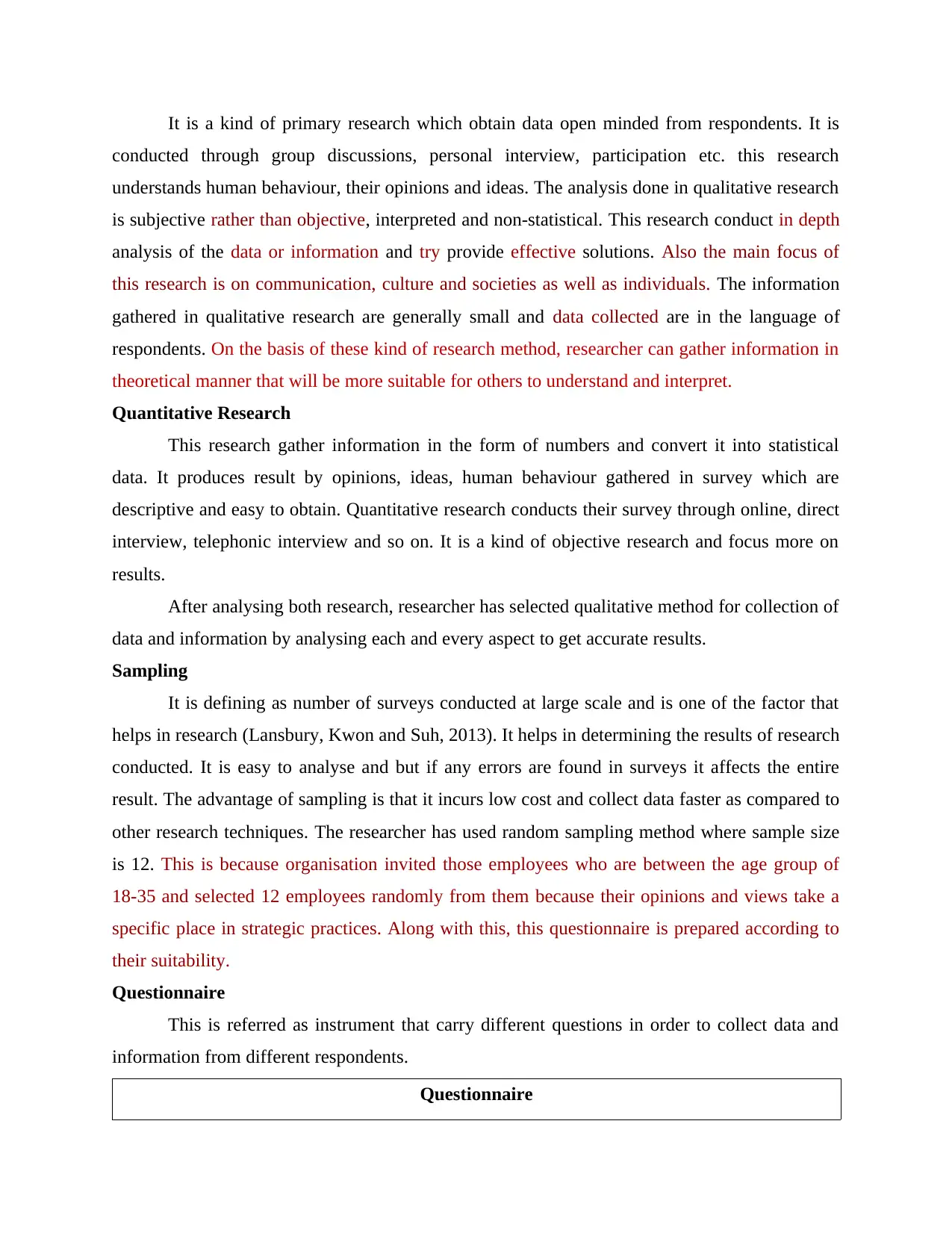
It is a kind of primary research which obtain data open minded from respondents. It is
conducted through group discussions, personal interview, participation etc. this research
understands human behaviour, their opinions and ideas. The analysis done in qualitative research
is subjective rather than objective, interpreted and non-statistical. This research conduct in depth
analysis of the data or information and try provide effective solutions. Also the main focus of
this research is on communication, culture and societies as well as individuals. The information
gathered in qualitative research are generally small and data collected are in the language of
respondents. On the basis of these kind of research method, researcher can gather information in
theoretical manner that will be more suitable for others to understand and interpret.
Quantitative Research
This research gather information in the form of numbers and convert it into statistical
data. It produces result by opinions, ideas, human behaviour gathered in survey which are
descriptive and easy to obtain. Quantitative research conducts their survey through online, direct
interview, telephonic interview and so on. It is a kind of objective research and focus more on
results.
After analysing both research, researcher has selected qualitative method for collection of
data and information by analysing each and every aspect to get accurate results.
Sampling
It is defining as number of surveys conducted at large scale and is one of the factor that
helps in research (Lansbury, Kwon and Suh, 2013). It helps in determining the results of research
conducted. It is easy to analyse and but if any errors are found in surveys it affects the entire
result. The advantage of sampling is that it incurs low cost and collect data faster as compared to
other research techniques. The researcher has used random sampling method where sample size
is 12. This is because organisation invited those employees who are between the age group of
18-35 and selected 12 employees randomly from them because their opinions and views take a
specific place in strategic practices. Along with this, this questionnaire is prepared according to
their suitability.
Questionnaire
This is referred as instrument that carry different questions in order to collect data and
information from different respondents.
Questionnaire
conducted through group discussions, personal interview, participation etc. this research
understands human behaviour, their opinions and ideas. The analysis done in qualitative research
is subjective rather than objective, interpreted and non-statistical. This research conduct in depth
analysis of the data or information and try provide effective solutions. Also the main focus of
this research is on communication, culture and societies as well as individuals. The information
gathered in qualitative research are generally small and data collected are in the language of
respondents. On the basis of these kind of research method, researcher can gather information in
theoretical manner that will be more suitable for others to understand and interpret.
Quantitative Research
This research gather information in the form of numbers and convert it into statistical
data. It produces result by opinions, ideas, human behaviour gathered in survey which are
descriptive and easy to obtain. Quantitative research conducts their survey through online, direct
interview, telephonic interview and so on. It is a kind of objective research and focus more on
results.
After analysing both research, researcher has selected qualitative method for collection of
data and information by analysing each and every aspect to get accurate results.
Sampling
It is defining as number of surveys conducted at large scale and is one of the factor that
helps in research (Lansbury, Kwon and Suh, 2013). It helps in determining the results of research
conducted. It is easy to analyse and but if any errors are found in surveys it affects the entire
result. The advantage of sampling is that it incurs low cost and collect data faster as compared to
other research techniques. The researcher has used random sampling method where sample size
is 12. This is because organisation invited those employees who are between the age group of
18-35 and selected 12 employees randomly from them because their opinions and views take a
specific place in strategic practices. Along with this, this questionnaire is prepared according to
their suitability.
Questionnaire
This is referred as instrument that carry different questions in order to collect data and
information from different respondents.
Questionnaire
Paraphrase This Document
Need a fresh take? Get an instant paraphrase of this document with our AI Paraphraser
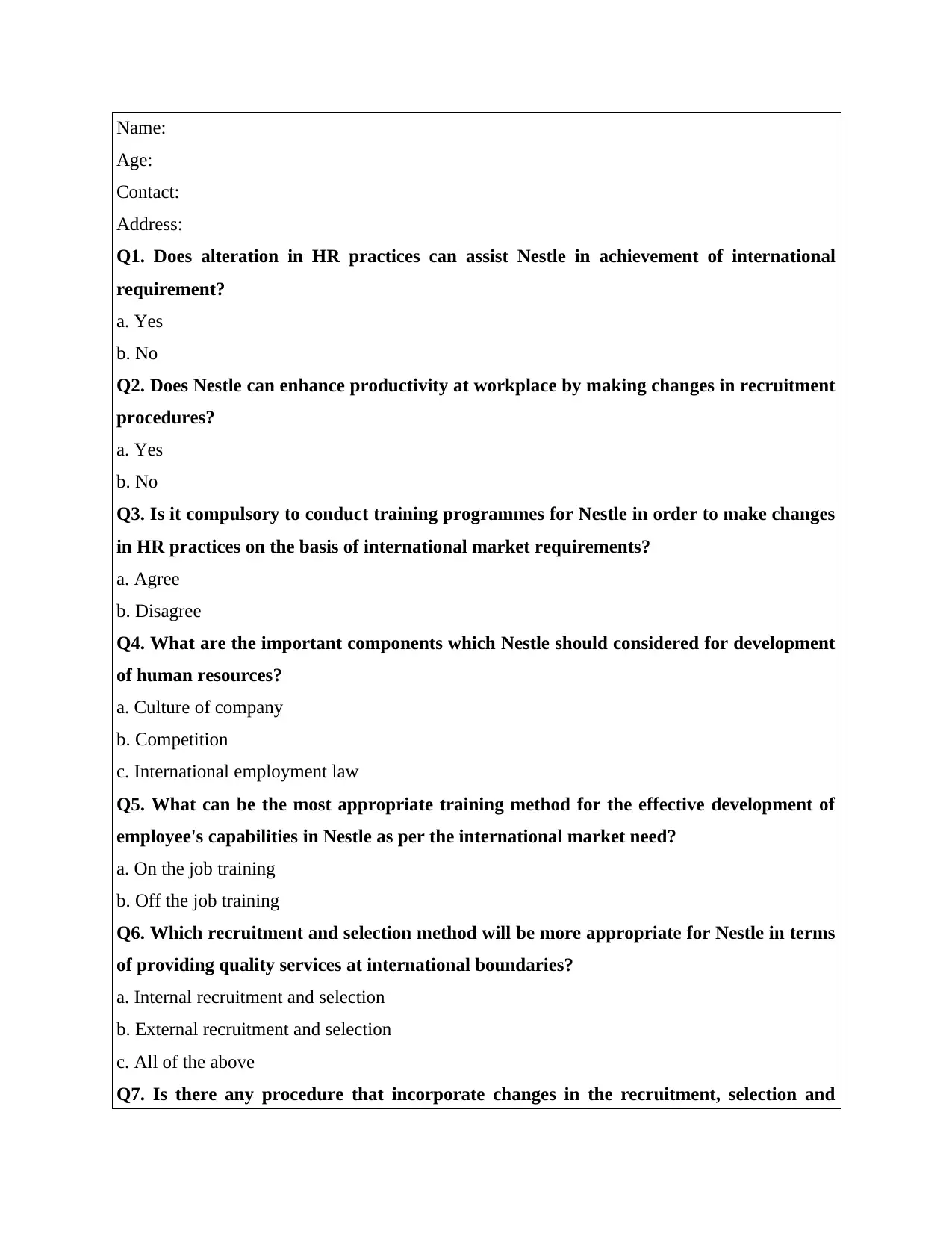
Name:
Age:
Contact:
Address:
Q1. Does alteration in HR practices can assist Nestle in achievement of international
requirement?
a. Yes
b. No
Q2. Does Nestle can enhance productivity at workplace by making changes in recruitment
procedures?
a. Yes
b. No
Q3. Is it compulsory to conduct training programmes for Nestle in order to make changes
in HR practices on the basis of international market requirements?
a. Agree
b. Disagree
Q4. What are the important components which Nestle should considered for development
of human resources?
a. Culture of company
b. Competition
c. International employment law
Q5. What can be the most appropriate training method for the effective development of
employee's capabilities in Nestle as per the international market need?
a. On the job training
b. Off the job training
Q6. Which recruitment and selection method will be more appropriate for Nestle in terms
of providing quality services at international boundaries?
a. Internal recruitment and selection
b. External recruitment and selection
c. All of the above
Q7. Is there any procedure that incorporate changes in the recruitment, selection and
Age:
Contact:
Address:
Q1. Does alteration in HR practices can assist Nestle in achievement of international
requirement?
a. Yes
b. No
Q2. Does Nestle can enhance productivity at workplace by making changes in recruitment
procedures?
a. Yes
b. No
Q3. Is it compulsory to conduct training programmes for Nestle in order to make changes
in HR practices on the basis of international market requirements?
a. Agree
b. Disagree
Q4. What are the important components which Nestle should considered for development
of human resources?
a. Culture of company
b. Competition
c. International employment law
Q5. What can be the most appropriate training method for the effective development of
employee's capabilities in Nestle as per the international market need?
a. On the job training
b. Off the job training
Q6. Which recruitment and selection method will be more appropriate for Nestle in terms
of providing quality services at international boundaries?
a. Internal recruitment and selection
b. External recruitment and selection
c. All of the above
Q7. Is there any procedure that incorporate changes in the recruitment, selection and
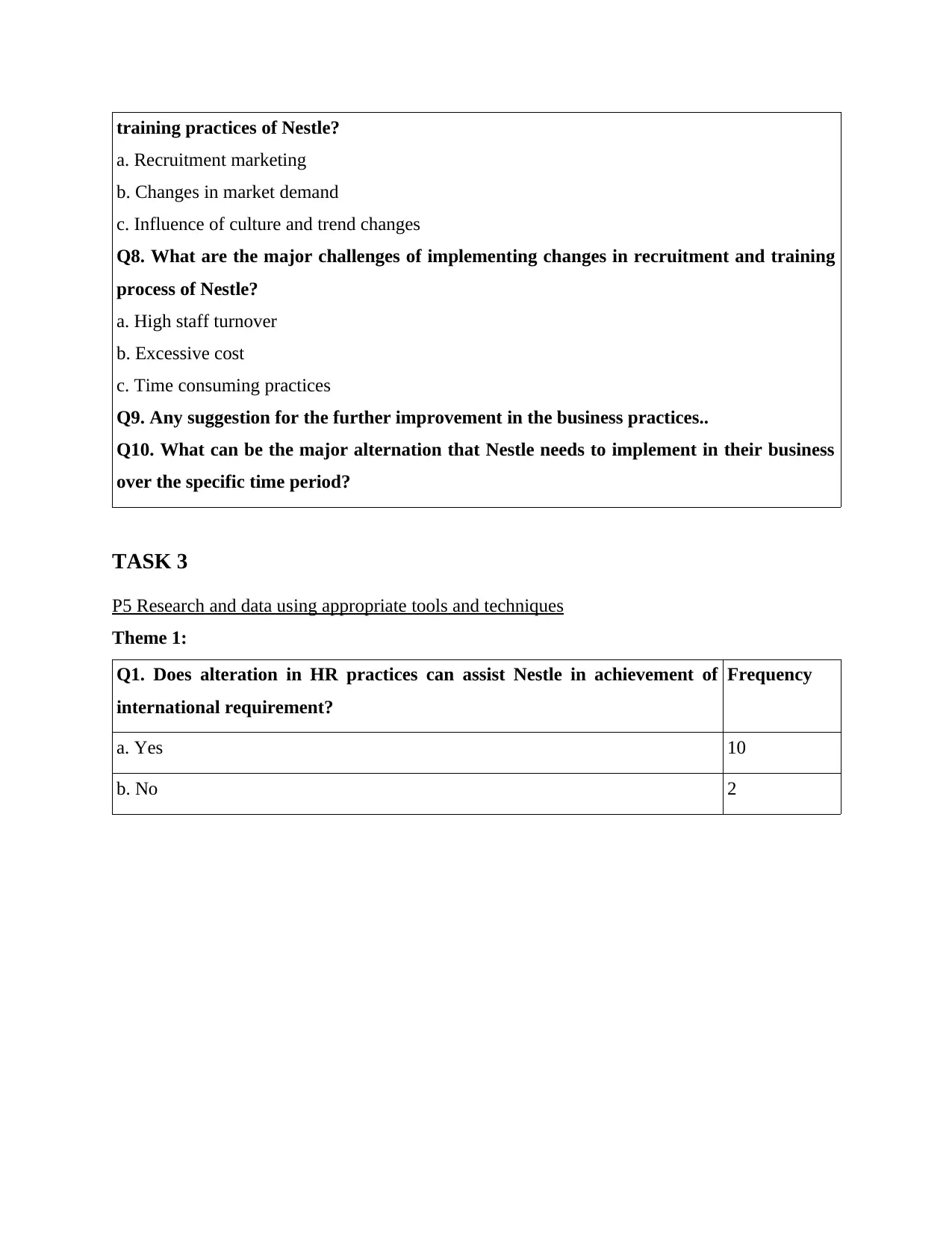
training practices of Nestle?
a. Recruitment marketing
b. Changes in market demand
c. Influence of culture and trend changes
Q8. What are the major challenges of implementing changes in recruitment and training
process of Nestle?
a. High staff turnover
b. Excessive cost
c. Time consuming practices
Q9. Any suggestion for the further improvement in the business practices..
Q10. What can be the major alternation that Nestle needs to implement in their business
over the specific time period?
TASK 3
P5 Research and data using appropriate tools and techniques
Theme 1:
Q1. Does alteration in HR practices can assist Nestle in achievement of
international requirement?
Frequency
a. Yes 10
b. No 2
a. Recruitment marketing
b. Changes in market demand
c. Influence of culture and trend changes
Q8. What are the major challenges of implementing changes in recruitment and training
process of Nestle?
a. High staff turnover
b. Excessive cost
c. Time consuming practices
Q9. Any suggestion for the further improvement in the business practices..
Q10. What can be the major alternation that Nestle needs to implement in their business
over the specific time period?
TASK 3
P5 Research and data using appropriate tools and techniques
Theme 1:
Q1. Does alteration in HR practices can assist Nestle in achievement of
international requirement?
Frequency
a. Yes 10
b. No 2
⊘ This is a preview!⊘
Do you want full access?
Subscribe today to unlock all pages.

Trusted by 1+ million students worldwide
1 out of 25
Related Documents
Your All-in-One AI-Powered Toolkit for Academic Success.
+13062052269
info@desklib.com
Available 24*7 on WhatsApp / Email
![[object Object]](/_next/static/media/star-bottom.7253800d.svg)
Unlock your academic potential
Copyright © 2020–2025 A2Z Services. All Rights Reserved. Developed and managed by ZUCOL.





